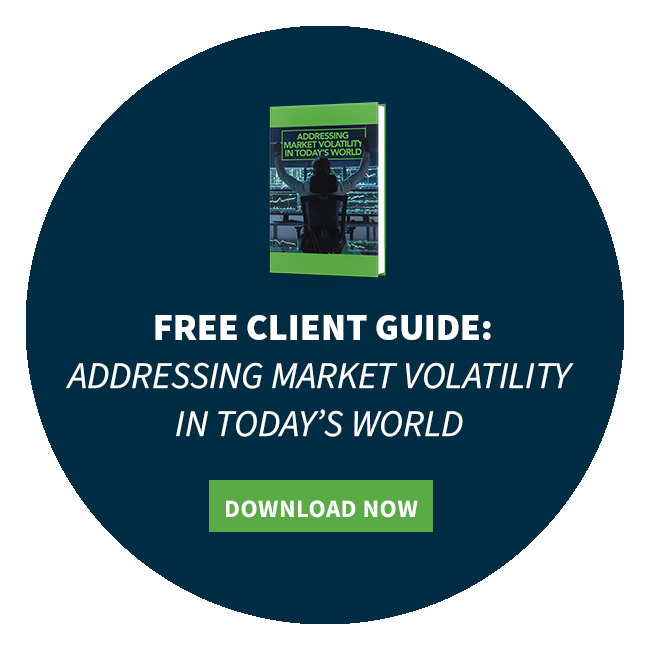“Market volatility is like someone riding up an escalator playing with a yo-yo. The yo-yo goes up and down like the stock market. But it doesn’t prevent the yo-yo from eventually reaching the next level.”
That analogy I learned years ago in an interview with a financial professional still resonates with me today.
We know market volatility fluctuates in response to industrial, political, regulatory, and economic developments or setbacks. Surely, we’ve had no lack of such news since the COVID-19 pandemic rattled the world.
However, the key barometer of market sentiment and volatility, the CBOE Volatility Index (or VIX), recently hit its lowest level since January 2020.
A low VIX isn’t necessarily a good long-term indicator of low market volatility. According to Seeking Alpha, this is because “the VIX is mean-reverting – it tends to spike back up after hitting historically low levels.”
That means that a volatility spike is almost always possible, so it makes sense to serve clients with the knowledge they need to handle volatility and keep their long-term financial goals in mind. Here are five market volatility facts and five thoughts that can help you address client concerns about the impacts of a volatile market.
5 Facts to Know About Market Volatility
1. The consumer price index (CPI) has declined for 11 consecutive months.
The combination of tightening credit, subsiding supply chain constraints, and higher interest rates have led to the annualized CPI inflation rate decreasing monthly for almost a year.
However, in May 2023, core inflation was still up 0.4% on a monthly basis and up 5.3% from May 2022. Food is still up 6.7% year over year. Housing costs continue to rise. But on the bright side, wages were 4.3% higher in May 2023 compared to a year earlier.
While there’s progress and hope that inflation may be declining for the long term, plenty of anxiety remains in the markets, which means your clients may still feel the effects of inflation in some capacity.
2. Investors believe marketing volatility is here to stay (for now).
According to a recent Allianz Life Insurance Company survey, 77% of Americans believe the market will be “very volatile” throughout 2023, with 62% of responders worrying about a possible recession.
3. More clients currently prefer safe avenues.
The same Allianz survey also found that 64% of Americans would rather have their money in cash than endure market swings. This may be a hurdle to overcome, but luckily with safe investments such as annuities, you can empower clients to have their money work for them rather than sitting on the sidelines.
If clients are hesitant about which direction to go, this quote from Kelly LaVigne, Allianz Life’s vice president of consumer insights, is something to keep in mind during your discussions:
“It’s understandable that people are worried about market risk…and while it might feel a little counterintuitive, it’s important to remember that money left out of the market – even in times of volatility – isn’t working hard for you. This money, while subject to potential market drops, will also miss out on gains when the market recovers. Timing the market is always a bad idea. Missing the days when the market performs best during recovery could postpone retirement for years.”
Kelly LaVigne, VP of Consumer Insights, Allianz Life
Related: How Annuities Can Address Client Issues
4. Slowed growth and inflation remain top of mind.
Recent economic growth hasn’t been rosy, and while inflation may have recently hit a two-year low, the threat of “stagflation” remains. Last quarter, one of the Fed’s favorite inflation gauges, the personal-consumption expenditures (PCE) index rose to a high of 4.9%, up from 4.4% in the previous quarter.
This, among other data points, adds pressure for the Fed to keep rates higher for a more extended period. However, this complicates the task of reducing inflation and minimizing economic damage. All this, of course, leads to weary clients and prospects who may be looking for answers to their financial worries.
5. 40% of pre-retirees are delaying retirement or believe they can’t retire due to financial uncertainty, with market volatility posing a significant challenge.
In Nationwide’s annual Advisor Authority survey, 25% of pre-retirees aged 55-65 plan to retire later, and 15% believe they may never retire.
With today’s unique and challenging landscape, 60% of responders say inflation is the greatest immediate challenge. And 36% believe market volatility poses the greatest threat to their retirement plans.
Pre-Retirees Gain Interest in Professional Financial Help
The good news is that pre-retirees are seeking portfolio guidance from financial professionals. In the same Nationwide survey, 49% currently work with a financial professional, and 40% recently began working with one in the last year.
To drive new conversations around a secure retirement, you can help clients understand their retirement goals to predict and plan for their futures.
Here are the survey results of the most likely reasons a pre-retiree would work with a financial professional:
- Strong experience providing for clients (37%)
- Recent or current market conditions (17%)
- Personalized and holistic financial advice (16%)
- The prospect of an economic recession (16%)
Related: Attracting & Managing High Net Worth Clients [Infographic]
5 Ways to Discuss Market Volatility With Clients
1. Keep long-term financial goals in mind.
Let’s be honest: market volatility is worrisome for most people. But we can also acknowledge the benefits of looking at volatility through a wider lens.
Looking at only the “here and now” can create anxious thoughts. It’s a good idea to remind clients that these feelings can negatively influence long-term financial goals.
Here’s an example: When the 2008-2009 financial crisis took the world by storm, the market plunged but ultimately rebounded. This gave way to the best bull market ever. Knowing it’s impossible to time markets, if a client has time to recover, remind them that their long-term goals are still very attainable.
2. Engage clients with strategies that protect their financial assets.
Build a more loyal and trusting relationship with clients by discussing real-world solutions to protect them from market instability.
Solutions such as index-linked annuities can help ease volatility fears. These products allow for potential market gains while safeguarding clients from substantial market losses.
3. Keep an eye on what happens next.
Few portfolios don’t feel market movements, so gathering intel on historical data, trends, and forecasts can never hurt. In your discussions, prepare your clients for what may be coming in the following weeks or months.
Being able to arm your clients with the knowledge of the potential future will strengthen their bond with you and prepare them for how the market unfolds.
4. Rely on education and perspective to keep clients on track.
As a financial professional, you have an excellent opportunity to provide context, information, and personal insights in your educational client engagement content.
Whether it’s a client guide, email campaign, or webinar—having a collection of ready-and-approved market volatility material can help you quickly and effectively get in front of your clients’ and prospects’ when public concerns are rising.
Pro tip: Download our free and customizable guide, Addressing Market Volatility in Today’s World, at the bottom of this article to educate your clients and prospects on ways to handle market volatility.
5. Send personal emails to uncover client concerns.
When market volatility is a trending topic, clients can be timid and unsure how to vocalize their wants and feelings. This can be especially true for specific clients during real-time meetings or conversations.
A way you can discuss market volatility with clients like these is to write a personal, thoughtful email empathizing with them and their fears about volatile markets. It’s an easy way to open a gateway for them. It allows time to sit down, really think about it, and write out their response with clear intentions.
Using this idea, you can earn more one-on-one discussions. You can also discover new financial solutions that can ease the fears and risks they’re perceiving.
Related: 7 Thoughts to Share With Those Anxious About Uncertain Markets
Final Thoughts
Ultimately, market volatility will affect each client differently. But you can help them avoid short-term thinking. Chances are, a given client has more progress to make toward their financial goals. As such, riding out the “market jitters” can be the best suggestion.
Along with the proper set of financial solutions and tools, you can better serve your clients in times of volatility by helping them keep their eye on the horizon.
Download our market volatility client guide below to help educate your audience
on market volatility and how you can address their concerns.
For Financial Professional Use Only



